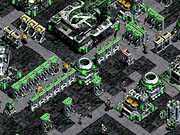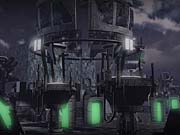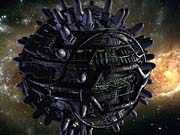Star Trek: Borg Assimilator Q&A
We chat with Cyberlore Studios to find out more about the upcoming Star Trek empire-building game.
Throughout the past several months, the Star Trek license has steadily increased in popularity among both developers and fans as a number of high-quality Star Trek games have stormed store shelves. However, most of these games focus on the Star Trek series' mainstay, the Federation, and some of the other popular races are left out entirely. The development team at Cyberlore Studios is taking a distinctly different approach to its Star Trek game by not only selecting the Borg as its featured race but also by creating the first empire-building game set within the Star Trek universe. We had a chance to speak with marketing manager Jan Adan, producer Jon Clark, art director Seth Spaulding, and engine architect Ken Grey to discuss Star Trek Borg Assimilator and to learn more about how the game plays, what kind of units are involved, and what the overall objectives are.

GameSpot: Can you tell us a little about the development team at Cyberlore Studios? How did the company come together, and what projects has it worked on?
Jay Adan: Cyberlore was started by Lester Humphreys, Herb Perez, and Ken Grey in 1992. Lester and Ken helped to create the last gold box SSI game, The Dark Queen of Krynn. Cyberlore's first project was Al-Qadim: The Genie's Curse--another SSI Dungeons & Dragons title. Cyberlore has averaged about one new title a year since the beginning, but most folks are familiar with us because of our work on Warcraft II: Beyond the Dark Portal and our latest title, Majesty: The Fantasy Kingdom Sim.
GS: What was the inspiration for creating a game based on one of Star Trek's most dominant races?
Jon Clark: Borg Assimilator is a wonderful way to explore the Borg in ways that haven't been done before. There is little question that the Borg are the most thrilling antagonists in the Star Trek Universe. They are quite different [from] any previous Star Trek villains. Their collective consciousness warranted a special approach as far as game development was concerned. The Borg have only been seen, through movies and the shows, out in space. We haven't seen them working planet-side, which really opens the doors for designing and expanding our knowledge of them. The opportunity to flesh them out certainly is exciting.
GS: How much freedom were you given in terms of creating the Borg universe? Are we going to see things we've never seen from the Borg before?
Jon: Cyberlore has been given a huge amount of freedom in the design and development of the Borg Colonies. Activision and Paramount have been incredibly open to the designs and art that we have come up with. This has really given the team the ability to push the envelope.
To address the second part of your questions, it is almost all new. You will see some familiar sights, like Regeneration Alcoves, Borg Cubes, and Spheres. The Assimilation Chambers are buildings where the drones bring individuals for assimilation, but there has never been any "place," outside of a Borg Cube Interior, where we have seen anything like this from the Borg. So to be more specific, yes, the player will see lots of things they've never seen before. We are using the Borg Queen to help build that transitional bridge from what the player knows about the Borg and what there is to learn from Borg Assimilator.
GS: Other Star Trek games have used Star Trek writers to help establish a story for the game much like Totally Games is using well-known Star Trek writer DC Fontana for Bridge Commander's story. Have you used any special consultants to establish a storyline for Borg Assimilator?
Jon: No. We have created our own storyline for BA and worked extensively on its development with both Activision and Paramount. Although we haven't brought in a specialist, per se, we have had talks with key individuals involved with production of the television shows and folks who have been making Star Trek games for a long time.
GS: Is the engine full 3D, or is it a mixture of sprites on a three-dimensional background?
Seth Spaulding: The engine is a full 3D engine that is capable of using traditional sprite art. All buildings and units are sprites, but the landscape is true 3D, and that aspect is apparent in the deformability of the terrain base.

Ken Grey: The engine is full 3D. Most of the characters and buildings in the game are rendered onto two triangle polygons that always face the camera. This is often referred to as "billboarding." The end result looks like a sprite but can have lighting and transparency effects accelerated in hardware. The landscape is a polygon mesh, and there are special effects objects that are 3D models.
GS: Can the camera pan around to get a different look on the action, or is it fixed in a default isometric perspective?
Ken: In Borg, the character art is prerendered with eight directions of view, the buildings with four directions. Even though the engine is full 3D, and its camera can rotate and pitch freely, we lock the view to the four prerendered directions of the building art. This means you can spin the camera but only in 90-degree increments.
GS: What type of game is Borg Assimilator? Is it more of an empire-building game like Zeus or Pharaoh, or is it similar to real-time strategy games such as Starcraft?
Jon: BA is similar to Zeus and Pharaoh in the sense that it is like an empire-building game. But it is also like SimCity in the sense that you have many tools to manage your "city." It isn't very much like Starcraft because you do not have direct control over your drones. You don't click on a drone and command it to go there and do that. You allocate drone resources to enable various systems that help you build, maintain, advance, and defend your colonies. Borg Assimilator seems to be in a class all unto itself.
Jay: People who are familiar with our previous title, Majesty, will probably have the easiest time grasping exactly what kind of game BA is. It has definitely been built on that foundation though it heads more in the direction of being a sim than Majesty did.
GS: Obviously, assimilation plays a huge role in the game. How do you assimilate other races in the game? Do you need to build specific structures and have special units, or can any Borg drone assimilate?
Jon: Assimilation of individuals happens through the creation and adaptation of Assimilation Drones. These guys are the ones that go out there and round up the assimilation candidates. They also assimilate enemy buildings and structures.
GS: What happens when you successfully assimilate an enemy? Do you gain its technology, and will this enemy serve you as a Borg drone?
Jon: Yes. When you assimilate an enemy, the immediate result is that you now have a brand spanking new drone. You can send that drone right off to work, or you can convert them into other types of drones more suited to your specific methodology of development and expansion for your colony.
GS: How much detail is there within the Borg environment? Do the drones move in and out of regeneration chambers? Are all of the traditional Borg sounds--like the "Resistance is futile" voice-- in the game?
Jon: There is a fantastic amount of detail both in the Borg Colony and the tools used to grow it. These tools are partially manifested through the vast array of Borg buildings and colony and drone management interfaces. The play has many roads that the player can choose to customize their colony. For example, the player can focus on the development of a strong military presence, but the game has far more depth than just combat.
Drones do flow through the Regeneration Alcoves, which can be manipulated to enhance them. The Alcoves also serve as a potential place for the spread of viruses and individuality, for example.
Yes, there will be the traditional Borg lines that we are all familiar with from the shows and movies. We are expanding their voice to suit the game, so there will be a good deal of new lines from our drone friends. We will also be using the Borg Queen voice extensively in the Game.
GS: How does the Borg Queen factor in?
Jon: The Borg Queen has the critical role of engaging the player and reeling them into their objectives. Although the Queen will not be making an appearance as a buildable unit, her presence is significant in orienting and guiding the player throughout the game.

GS: As you progress through the campaign mode, you face stronger resistance from other races. How do the various campaigns unfold? Is the enemy building a base the same time you are, or is it just a question of building up your own base and then attacking a prebuilt enemy installation?
Jon: The campaigns are aimed at expanding your colonial power throughout a star system. Each acts as a building block and resource for the next level. The earlier campaign levels are focused on getting the player into the Borg mind-set and leveraging the vast array of tools needed to succeed. The later campaign levels test what you have learned.
The campaigns are not as simple as just building up an army to squash or assimilate your enemies. Enemy settlements and military installations will be well supported by off-map enemy missions and special events. In some cases, there will be enemy expansions during gameplay. We are running the gamut of possibilities.
GS: Does the game start out in the delta quadrant, or is it only in the alpha quadrant? Will we see Species 8472?
Jon: The Scenarios are all based in the alpha quadrant. The Borg are making a play for control of the quadrant, and if the player plays their cards right, the Borg will achieve perfection. Species 8472 will be popping up from time to time. It would be neglectful on our part not to reserve a seat for the Borg's most formidable enemy.
GS: Have there been any significant setbacks during development?
Jon: Nope. The development of a computer game always has some challenges, and I would be lying if I said that everything has been a cakewalk. However, we have a very professional and experienced team, a very mature engine, an excellent publisher, and a passionate love for what we do. So, any challenges to this point have been handled with the least possible amount of impact on our production schedule. The coffee machine was down for a few days, and it was ugly.
GS: How close is the game to being completed?
Jon: We will have our first playable ready for E3, and the game should ship this winter.
GS: Thanks for your time.
Got a news tip or want to contact us directly? Email news@gamespot.com
Join the conversation